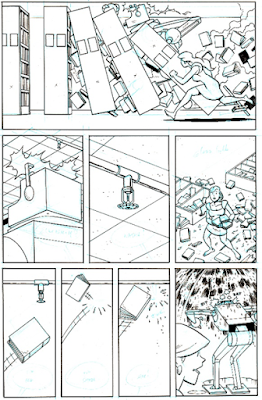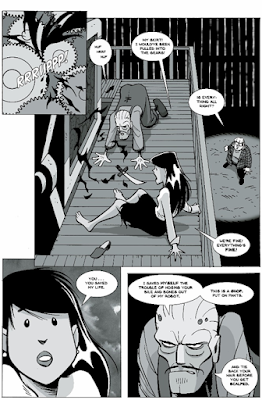Until this morning, my publisher Abrams and I were working with an overseas publisher to print a foreign-language edition of The Last Mechanical Monster. (I'm being deliberately cagey about the country and language.) It would have been a good book. In addition to reprinting the translated story, they wanted to include a ton of extra material in the back: sketches, early drafts, an interview, etc. Although most of the original artwork for The Last Mechanical Monster was lost when my house burned down in 2017, many digital scans and photos were on my computer back-up, which I grabbed on the way out. More survived than I'd thought.
Through no fault of mine or Abrams's--in fact, despite quite a bit of time and effort on our parts--the deal just fell apart. Frustrating and disappointing. However, since I had all this extra stuff pulled together, I thought I'd share it here. Lemons, meet lemonade.
First Draft
My very earliest draft of The Last Mechanical Monster goes back to about 2009, right after Whatever Happened to the World of Tomorrow? I had always loved the Fleischer Superman cartoon, “The Mechanical Monsters,” and thought to create a sequel to it. Since the copyright to the cartoon expired in the 1960s, and I had no intention of using the characters of Superman or Lois Lane, I thought it was a story ripe to be continued. Whatever happened to the Inventor and his robots?
My first draft of the story was very different from the published version. That draft featured a young journalist writing an article about the mechanical monsters. She had managed to find several robots that avoided destruction because they were absent from the inventor’s lair when Superman attacked. I made a list of every robot whose number appeared in the cartoon, and figured there were seven unaccounted for.
In my story, one was later used during atomic bomb testing in the 1950s. One was turned into a carnival ride. Another was lost at sea while working on an oil rig. And one was in the barn of a retired engineer named Lillian, who was almost killed by the robot when she was a child and was now trying to restore it. The journalist interviewed the Inventor in prison. When she revealed that at least one of his robots had survived, he escaped and made his way to Lillian’s barn, where the three characters worked to bring the robot back to life.
I wrote and made rough-draft drawings (“thumbnails”) for the entire story, and had drawn about 100 pages of it, when I decided I needed to start over. I realized that the story I was telling was not actually the story I wanted to tell! I wanted to see the old Inventor back in his cavern lair, wearing his old tuxedo. I wanted him, not the journalist, to drive the story. I also wanted the story to be more fun! So I turned over those 100 pages and began drawing a new story on their backs. That became a webcomic that became the first draft of the book.
These are some of the preliminary thumbnail drawings of the abandoned earliest draft.
 |
| Some of the nearly 200 pages I thumbnailed before realizing the story wanted to take me in a different direction. |
 |
| A two-page spread of the Robot doing training drills in the skies over Proto-Lillian's farmhouse. |
 |
| The earliest draft of the story ended with Lillian's robot heroically destroyed, but another found rusting at the bottom of the ocean. The LAST Last Mechanical Monster? |
Finished First-Draft Art
When working on the first-draft thumbnails, I did more-finished versions of some pages to see how they might look when done. At this point I thought they might be published in grayscale—shades of black, white and gray—and so prepared some pages that looked like this. This is still from the first abandoned draft featuring the journalist character that I later dropped.
Preparation
In preparation for doing The Last Mechanical Monster, I made a wood model of the robot so I could draw its proportions consistently and correctly.
I also used a simple 3D rendering program (SketchUp) to make a digital model of the robot that I could pose and turn around in space. Here I used it to make an image of the robot that looks three dimensional when viewed through red-blue 3D glasses. I originally hoped to use a lot of 3D images in the story but later decided to tone it down to a couple of spots where it would have narrative impact.
Also, as part of my drawing and coloring process, I made up detailed color palettes for each character and location in the story. Each has a distinct feel and personality that is partly expressed through color. I try to be very thoughtful about how I use color. It is a tool that can convey meaning or evoke emotions without a reader even realizing it. My challenge is understanding how to use that tool most effectively for the good of the story. I wrote quite a bit more about my approach to color in The Last Mechanical Monster in an earlier post.
Process
I make comics the old-fashioned way. Although many of my friends and colleagues have gone to digital art, I still take great joy in putting ink on paper. That’s the fun part for me. I don’t expect to ever stop. However, for The Last Mechanical Monster, I did letter and color the story using Photoshop and a typeface made from my own hand lettering.
 |
| After penciling, I then go over the blue lines in black ink. I use a variety of brushes, nibs, pens, and brushpens. The small “X” marks are areas I plan to fill in with black. |
***********
Back to me in the present: Wouldn't that have been neat material to include with the book? I was looking forward to what might have been the definitive "artist's edition" of The Last Mechanical Monster (albeit it in a language I don't understand).
Alas.
Alas.
The Last Mechanical Monster taught me a couple of lessons that maybe others can learn from. First, the many months of work I did on the aborted first draft weren't wasted. I had to do that preliminary work, and draw those 100 pages, to get to the story that I really wanted to tell. It was kind of a sucky process and I wish I'd figured it out sooner, but it worked.
So Lesson One: Don't fall for the Sunk Cost Fallacy: "Oh, I already put so much time and work into it, I can't start over." If you have a better idea, start over. I didn't regret it for a second.
Lesson Two: From initial idea to earliest draft to self-published webcomic to GoComics.com webcomic to published graphic novel took something like 14 years, constantly evolving as it went. I was doing other work at the same time (including A Fire Story, another book idea that it turns out is never gonna happen, and yet another book idea that might still happen), but The Last Mechanical Monster was always percolating on a back burner.
I think there's a fine line: don't waste your whole life banging your head on the brick wall of one fruitless project, but if you think you've got a nugget of something good, grind and hone and polish and shine it for as long as it feels like you're making progress toward something better. There's a chance you'll end up with a pile of sand, but also a fair chance you'll produce a fine little gem.













No comments:
Post a Comment